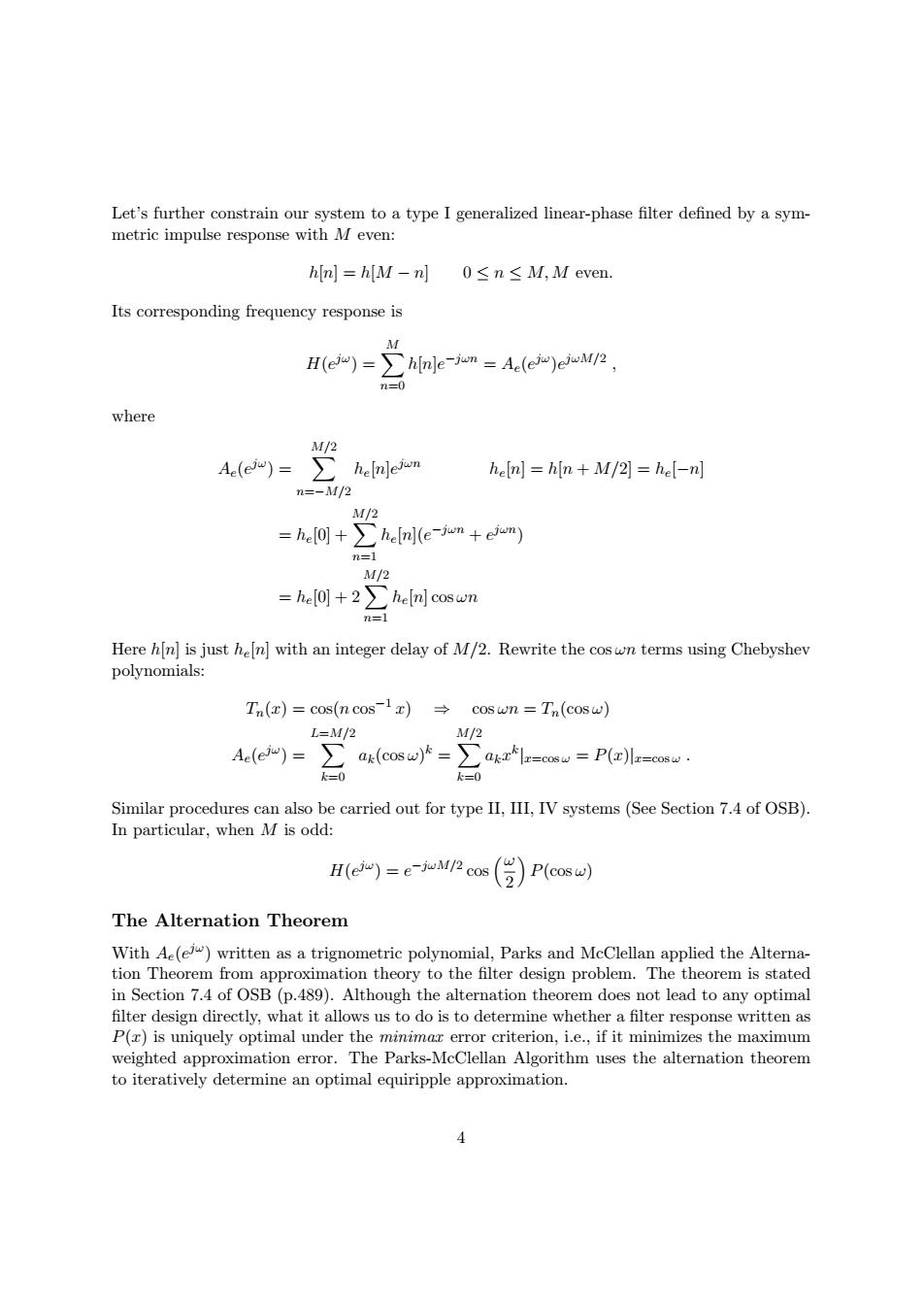正在加载图片...

Let's further constrain our system to a type I generalized linear-phase filter defined by a sym- metric impulse response with M even: hin]h[M-n] 0≤n≤M,Ieven. Its corresponding frequency response is M H(eiu)=>hinle-jun =Ae(ei)ejM/2, n=0 where M/2 Aeleiv)=>helnlejwun heln]hin M/2]hel-n] n=-M/2 M/2 he[o]+he[n](e-jun +eiwm) n=1 M/2 =heI0+2∑hen]coswn n=1 Here hn]is just heln]with an integer delay of M/2.Rewrite the coswn terms using Chebyshev polynomials: Tn(z)=cos(ncos-1x)coswn Tn(cosw) L=M/2 M/2 Ae(ei)=> ak(cosw)=∑ak=asw=P(rlz=osw· k=0 k=0 Similar procedures can also be carried out for type II,III,IV systems(See Section 7.4 of OSB) In particular,when M is odd: H(ejw)=e-juM/2 cos (份)Posw) The Alternation Theorem With Ae(e)written as a trignometric polynomial,Parks and McClellan applied the Alterna- tion Theorem from approximation theory to the filter design problem.The theorem is stated in Section 7.4 of OSB (p.489).Although the alternation theorem does not lead to any optimal filter design directly,what it allows us to do is to determine whether a filter response written as P()is uniquely optimal under the minimax error criterion,i.e.,if it minimizes the maximum weighted approximation error.The Parks-McClellan Algorithm uses the alternation theorem to iteratively determine an optimal equiripple approximation. 4Let’s further constrain our system to a type I generalized linear-phase filter defined by a symmetric impulse response with M even: h[n] = h[M − n] 0 ≤ n ≤ M, M even. Its corresponding frequency response is M e−jωn = Ae(ejω)e H jωM/2 (ejω) = �h[n] , n=0 where M/2 jωn Ae(ejω) = � he[n]e he[n] = h[n + M/2] = he[−n] n=−M/2 M/2 n](e−jωn + ejωn = he[0] + ) �he[ n=1 M/2 = he[0] + 2 �he[n] cos ωn n=1 Here h[n] is just he[n] with an integer delay of M/2. Rewrite the cos ωn terms using Chebyshev polynomials: Tn(x) = cos(n cos−1 x) ⇒ cos ωn = Tn(cos ω) L=M/2 M/2 k Ae(ejω) = � ak(cos ω) k = �akx |x=cos ω = P(x)|x=cos ω . k=0 k=0 Similar procedures can also be carried out for type II, III, IV systems (See Section 7.4 of OSB). In particular, when M is odd: H(ejω) = e−jωM/2 cos �ω� P(cos ω) 2 The Alternation Theorem With Ae(ejω) written as a trignometric polynomial, Parks and McClellan applied the Alternation Theorem from approximation theory to the filter design problem. The theorem is stated in Section 7.4 of OSB (p.489). Although the alternation theorem does not lead to any optimal filter design directly, what it allows us to do is to determine whether a filter response written as P(x) is uniquely optimal under the minimax error criterion, i.e., if it minimizes the maximum weighted approximation error. The Parks-McClellan Algorithm uses the alternation theorem to iteratively determine an optimal equiripple approximation. 4